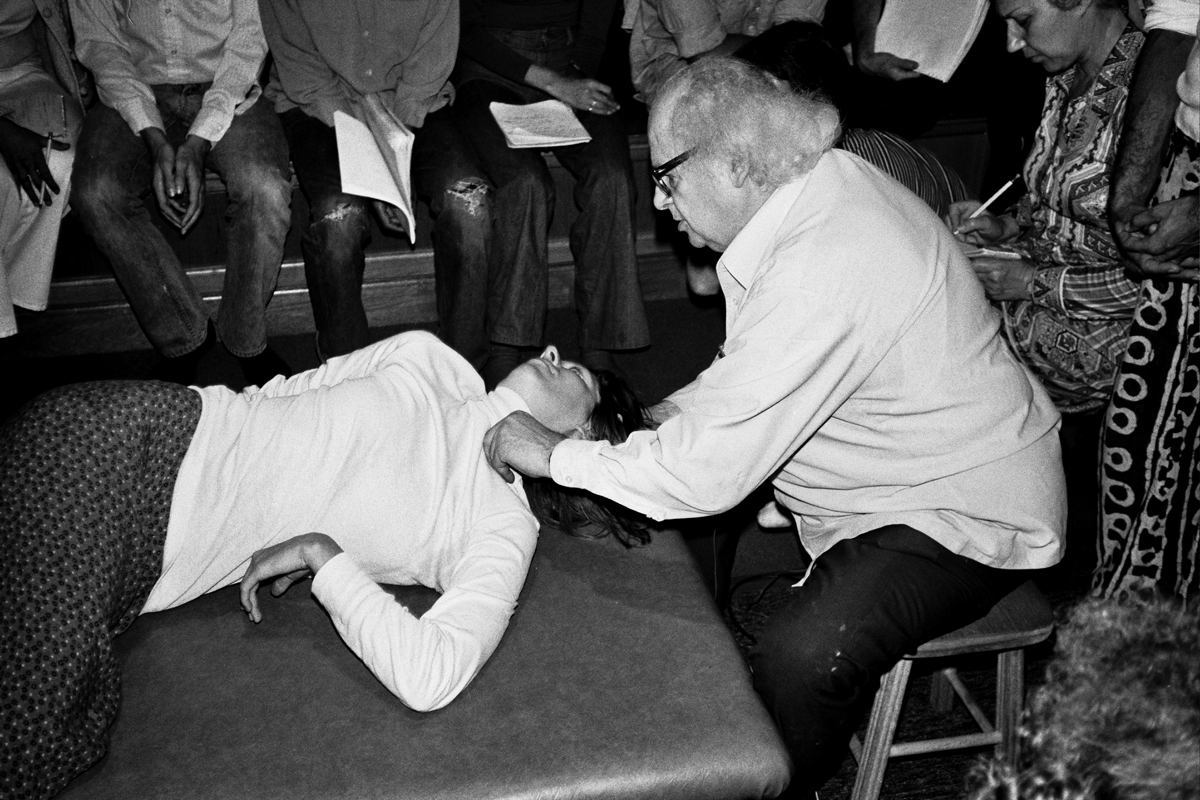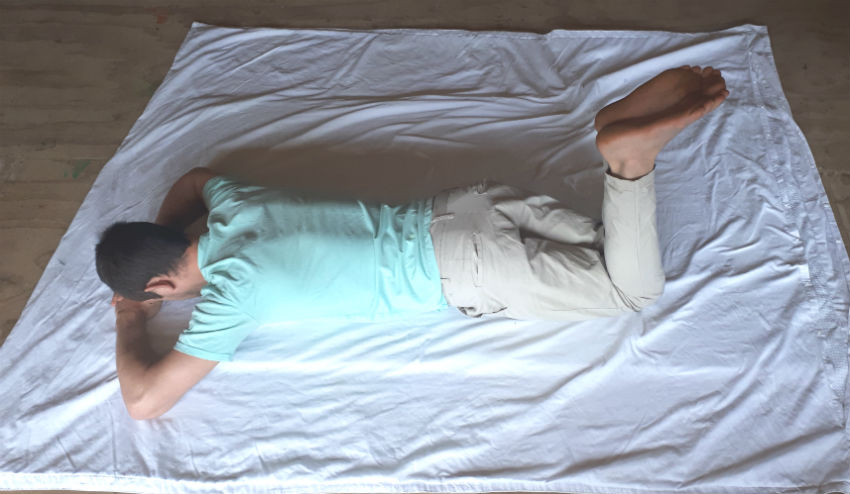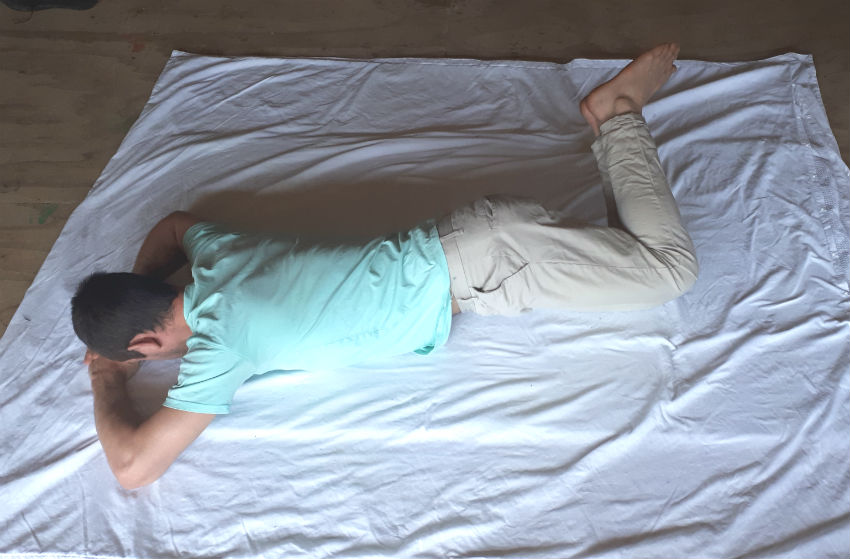Check Out This Sneaky Brain-Loophole For Solving Neck Pain
I've been tricked! But in the best way possible. As I stand here looking around I feel taller and lighter than I can ever remember. My head seems as though it's floating above my body. What a stark contrast to the stiff and painful feeling in my neck of an hour ago.
I had just finished a movement lesson as part of my professional training. It involved lying on my tummy and doing all sorts of strange movements with my legs...ie: visualising them tied together with rope and tilting them over to the side. Weird!
I chuckle. I had no idea that this lesson had anything to do with my neck. I'm excited, amazed, in awe. But mostly inspired.
"You've done it again Moshé, you've tricked me out of my pain."
Yes... I know that's an unusual statement. For 2 reasons.
Firstly, most people don't think of pain as something that they can be tricked out of. But as you'll see in a minute, it's absolutely true. I'm going to explain how neurological wizardry is the way out of pain and into freedom. My hope is that this changes the way you think about and approach pain.
Secondly, who is Moshé anyway?
If you've never heard of Moshé Feldenkrais. He was an incredible trickster. A trickster of the most caring kind. He was able to neurologically trick people out of their pain and suffering.
I've seen video's of Moshé working with people. It takes watching these video's over and over just to pick up all the subtle layers of strategy, technique and purpose he was using to help people move through their limitation. The level of mastery of his craft was just incredible.

Despite the fact that Moshé is no longer with us on earth, he still continues to help people. While he was alive he crafted a huge number of lessons which are available for the benefit of humanity. These lessons contain all the juiciest strategies he used in his one-on-one work.
In my training I spent a lot of time on the floor doing these lessons. Each one was an educational piece to help inform and upgrade the movement patterns in my nervous system. They are what I now teach in my weekly classes.
These lessons have got LOTS of different strategies woven in to them. Each of them designed to interrupt our habitual ways of doing things.
Why is that important? Well...
When it comes to chronic pain, habits are EVERYTHING
The first thing you should know about pain is that it's a neurological phenomenon. That is, it's created by your brain. It doesn't come from your tissues where the pain is felt. That's why amputee's can experience "phantom limb pain" - pain in limbs that are no longer there.
The second thing you should know about pain is that it's a protective warning signal. Your brain generates an unpleasant feeling to stop you from doing things that can harm you.
So if you've injured yourself and the pain has become chronic (defined as lasting longer than 3 months) then the tissues which were originally damaged have already had enough time to heal. Which means that either...
- You're continuing to cause actual damage to yourself through your habitual way of moving, or...
- Your brain has become hypersensitive and is sending out unnecesary pain signals...
In either case, addressing the underlying subconscious habits is the way to change your pain.
The trick I'm about to share with you will simultaneously change your movement so that you aren't causing damage AND it will turn off unnecesary pain signals.
Here it is...
This is one of my favourite tricks for retraining your brain out of pain
Let's imagine someone who had a whiplash accident. In the crash they damaged some of the tissues in their neck. But now, 2 years down the track, the tissues have healed and the pain is still there. Every time they turn their head to the right, they get intense shooting pain up into their head.
If we go back to those key understandings. Pain is...
- Generated by your brain
- A protective mechanism.
This person's brain generates pain to stop them from turning their neck. It's attempting to protect them from additional neck damage by avoiding the movement all together. This was probably a useful strategy immediately after the injury. But now...2 years on, it's likely the pain is just a habit. Uh oh!
So how do we change this?
Well think about it from the perspective of your skeleton. When you look to your right, your skull turns and the spine below twists like a rope. Each vertebrae in turn rotates a little relative to the one below it. Depending on how far you look will determine how many of your vertebrae are involved in the twist.
From a brain perspective... The brain says "Alrighty folks, we're about to do the 'turn head' pattern. Let's get organized. First turn the eye's, then the neck muscles, it's not safe to go beyond 50 degree's so we're going to stop well before then. Turn on the pain and hit the brakes when you get to 30 degree's. That'll keep us safe."
Perhaps you have experienced the pattern-like nature of this. If you've ever had pain during a movement, perhaps you've noticed that you can pinpoint where in the movement the pain will "turn on" before you even get there. It's like the pain is written into a set of instructions for how to do that movement.
Now here's where the magician work comes in
To aid my explanation, here's a bit of simple anatomical jargon.
1. Proximal...Something that's closer to the centre of your body.
2. Distal...Something that's further away from the centre of your body.
For example: Your knee is more distal than your hip. Your knee is more proximal than your foot. Make sense?
Most time's when people move they are moving the distal part over the proximal part. That's what people do when they turn their head. The head (distal) turns and the torso (proximal) stays still.
But if we swap that around so the distal part stays still and the proximal part moves, we get a completely different result! This is the equivalent of keeping your head still and turning your torso.
On the level of your skeleton, the same movement is happening. A twist is still happening through your spine.
However, from a brain perspective, the movement seems completely foreign. It also seems a lot safer. The pain signal (which is associated with the habitual turning of your head), is no longer fired off.
And then your brain goes... "Hang on... we just rotated that vertebrae, and it was... FINE...hmmmm everything must be okay now... let's stop sending pain there..."
And ta da...the movement pattern gets "re-educated" and there's no more pain!
Pretty trippy right.
How To Help Your Neck Pain On A Practical Level
The best way to do this is by lying face down on the floor with your knee's bent. In this position it is possible to start the twist of your spine from the other end. If you start to lean your legs to one side, your pelvis will roll and your spine will begin to twist. But your head will stay still! Repeat this movement many times with plenty of rests.


If you can manage to (this is the hard part) practice in such a way that you are...
- Breathing freely without interruption
- Staying in a comfortable range of motion (away from your limit)
- Using minimal effort, (like really minimal!)
- Moving S-L-O-W-L-Y
...you will find that your neck pain magically disappears.
No need to do stretching. No need to get manipulated or "fixed"... Simply learn how to work with yourself in an intelligent and gentle way. That's how to stay out of pain and move with ease.
Pretty sweet huh!
And in case you're wondering...
This is Not Limited To Neck Pain
Even though I just described how this trick can help neck pain, it actually works for pain in other parts of your body too. Jaw, Hip, Shoulder, Foot, Back, Whatever! It's still just a matter of reversing the proximal and distal parts involved in the movement. This will allow you to...
- Get out of you current habitual way of moving.
- Glide under the radar, re-educate your movement and desensitize your brain to the pain.
And of course, this strategy is only one of many that Moshé developed. He needed lots of strategies because we humans are slippery creatures sometimes. Pain can become part of our identity and we can subconsciously sabotage attempts to let it go. We can hold onto pain because we fear the unknown of the life without it.
So, if YOU are in chronic pain, just know that there IS a way out. If you're struggling to get this technique to work don't despair, you may just need some help or you may need another strategy.
The intention of my work and this website is to share these ideas as widely as possible. This stuff is SO effective and yet barely known. Imagine a beautiful world where people were empowered with the tools and understanding to take care of themselves and each other in this way.
Our people are in a pain epidemic, but it doesn't have to be that way!